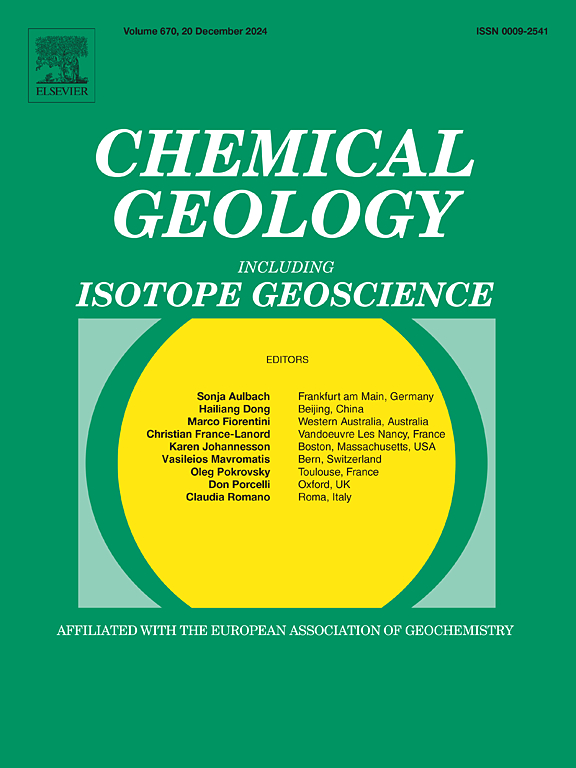Strontium isotope and trace element compositions of olivine-hosted melt inclusions from the Song Da ultramafic volcanic suite, northern Vietnam: Implications for chemical heterogeneity in mantle plumes
IF 3.6
2区 地球科学
Q1 GEOCHEMISTRY & GEOPHYSICS
引用次数: 0
Abstract
Ultramafic magmas are the ideal tracеrs of mantle composition, as they are derived from high degrees of partial melting and their compositions approach that of mantle peridotite. The Permian Song Da ultramafic volcanic rocks in northern Vietnam represent a rare example of well-preserved Paleozoic picrites of the Emeishan Large Igneous Province (ELIP), with the most Mg-rich olivine phenocrysts of up to Fo93.5. As such, they are invaluable for constraining temperature, pressure, and composition of the ELIP mantle source. Here, we report the results of a study of olivine-hosted melt inclusions from ultramafic lavas of both low-Ti and high-Ti types in the Song-Da zone of the ELIP, providing new information on the concentrations of mobile trace elements, volatile components, and Sr isotope compositions of parental melts. Our data suggest a significant difference between the mantle source compositions of low-Ti and high-Ti primary melts of the Song Da zone. The latter melt likely originally contained 2.7 ± 1.2 wt% CO2 and 0.6 ± 0.1 wt% H2O, but lost most of its volatile inventory during degassing. Its enrichment in trace elements is attributed to a low degree of partial melting (less than 9 %) of a PREMA-type peridotitic source, as evidenced by the bulk rocks Nd and melt inclusions Sr isotopic data, contaminated by metasomatic fluids or recycled components bringing Pb, Sr, and Na. The low-Ti komatiite-type Song Da melts contain an excess of H2O (H2O/Ce up to 5500), similarly to some Archean komatiites, show a decoupling of Nd and Sr isotopes, and reveal mixing of at least two unusual components: (1) one with low initial 87Sr/86Sr (down to 0.7040), low Nb/U and Ce/Pb ratios and relatively enriched in La, Th, U, Pb, and Sr, and (2) the other with high initial 87Sr/86Sr (up to 0.7080), high Nb/U and Ce/Pb ratios, and strongly depleted in highly incompatible lithophile elements such as Ba, Rb, Nb, K, U, Th, La, and Sr. We suggest that component (1) reflects contamination with lower continental crust or other subduction-related constituents in the mantle source, while component (2) represents partial melt derived from dehydrated seawater-altered recycled harzburgite that was part of a subducted oceanic slab 300 to 500 Ma in age. The latter component can be recognized only in the melts that are exceptionally depleted in highly incompatible elements. The data from this study and Kazzy et al. (2024) suggest that the ELIP was produced by a mantle plume with a maximum potential temperature (Tp) of ∼1600 °C at ∼260 Ma. Because of its high temperature, this plume passed through the hydrated mantle transition zone (MTZ) in a partially molten state, which allowed it to entrain in its hottest part H2O and components of the subducted 300–500 Ma Paleo-Tethyan oceanic plate stagnated in the MTZ for ∼200 Ma. An alternative source of dehydrated serpentinites of recycled Paleo-Tethyan slab in the Emeishan mantle plume could be a core-mantle boundary if this slab had been subducted shortly (less than 240 Ma) before the initiation of this plume. This option requires a fast Tethyan crust recycling rate of >2.3 cm/year. Low-Ti komatiite-type melts of the Song Da area came from the hottest part of the Emeishan mantle plume and contain traces of these components, whereas the high-Ti Song Da melts came from the coldest part of the Emeishan mantle plume (Tp ∼1450 °C) and reflect a PREMA-type mantle source metasomatized by addition of a component enriched in Na, Sr, and Pb.
越南北部宋达超镁铁质火山岩套中橄榄石熔融包裹体的锶同位素和微量元素组成:地幔柱化学非均质性的意义
超镁铁质岩浆是地幔成分的理想追踪者,因为它们来自于高度的部分熔融,它们的成分接近于地幔橄榄岩。越南北部二叠系宋大超镁铁质火山岩是峨眉山大火成岩省(ELIP)中保存完好的古生代苦橄辉岩的罕见例子,其富镁橄榄石斑晶最高可达Fo93.5。因此,它们对于约束ELIP地幔源的温度、压力和组成是无价的。本文报道了ELIP松达带低钛型和高钛型超基性熔岩中含橄榄石的熔体包裹体的研究结果,为母熔体的流动微量元素浓度、挥发性组分和Sr同位素组成提供了新的信息。我们的数据表明,低钛和高钛原生熔体的地幔源组成存在显著差异。后一种熔体最初可能含有2.7±1.2 wt%的CO2和0.6±0.1 wt%的H2O,但在脱气过程中失去了大部分挥发性成分。其微量元素的富集是由于prema型橄榄岩源的部分熔融程度较低(小于9%),岩石体Nd和熔体包裹体Sr同位素数据证明了这一点,并受到交代流体或带Pb、Sr和Na的循环组分的污染。低钛科马长石型宋达熔体含有过量的H2O (H2O/Ce高达5500),与一些太古宙科马长石类似,显示出Nd和Sr同位素的解耦合,并显示出至少两种不寻常成分的混合:(1)低初始87Sr/86Sr(低至0.7040),低Nb/U和Ce/Pb比值,相对富集La、Th、U、Pb和Sr;(2)高初始87Sr/86Sr(高至0.7080),高Nb/U和Ce/Pb比值,强烈缺乏Ba、Rb、Nb、K、U、Th、La和Sr等高度不相容的亲石元素。我们认为,组分(1)反映了下陆壳或地幔源其他俯冲相关成分的污染。组分(2)代表部分熔体,来自于脱水海水蚀变的再循环辉石,该辉石是300 ~ 500 Ma年龄的俯冲洋板的一部分。后一种成分只有在高度不相容元素异常耗尽的熔体中才能被识别出来。这项研究和Kazzy等人(2024)的数据表明,ELIP是由最高潜在温度(Tp)为~ 1600°C、~ 260 Ma的地幔柱产生的。由于其高温,该羽流以部分熔融状态通过水合地幔过渡带(MTZ),这使得它在其最热的部分携带H2O,并且俯冲的300-500 Ma古特提斯海洋板块的成分在MTZ停滞了~ 200 Ma。峨眉山地幔柱中再循环古特提斯板块脱水蛇纹岩的另一个来源,如果该板块在该地幔柱开始前不久(小于240 Ma)俯冲,则可能是一个核幔边界。这一选择要求特提斯地壳的再循环速度达到2.3厘米/年。宋达地区低钛科马岩型熔体来自峨眉山地幔柱最热部分,含有这些成分的痕迹,而高钛宋达熔体来自峨眉山地幔柱最冷部分(Tp ~ 1450°C),反映了一个prema型地幔源的交代作用,其中添加了富含Na、Sr和Pb的成分。
本文章由计算机程序翻译,如有差异,请以英文原文为准。
求助全文
约1分钟内获得全文
求助全文
来源期刊

Chemical Geology
地学-地球化学与地球物理
CiteScore
7.20
自引率
10.30%
发文量
374
审稿时长
3.6 months
期刊介绍:
Chemical Geology is an international journal that publishes original research papers on isotopic and elemental geochemistry, geochronology and cosmochemistry.
The Journal focuses on chemical processes in igneous, metamorphic, and sedimentary petrology, low- and high-temperature aqueous solutions, biogeochemistry, the environment and cosmochemistry.
Papers that are field, experimentally, or computationally based are appropriate if they are of broad international interest. The Journal generally does not publish papers that are primarily of regional or local interest, or which are primarily focused on remediation and applied geochemistry.
The Journal also welcomes innovative papers dealing with significant analytical advances that are of wide interest in the community and extend significantly beyond the scope of what would be included in the methods section of a standard research paper.
 求助内容:
求助内容: 应助结果提醒方式:
应助结果提醒方式:


